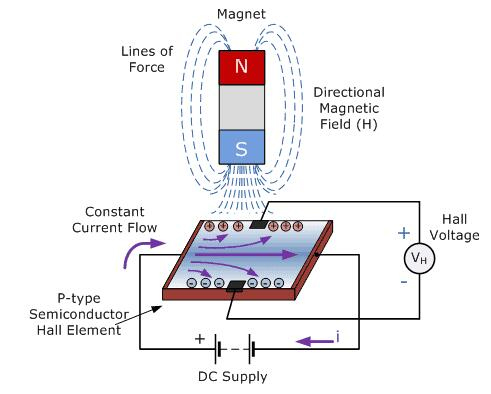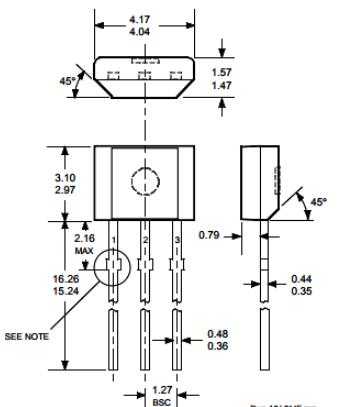A3144 Hall Effect Sensor: Pinout, Alternatives, and Applications
This article explores the multifaceted aspects of the A3144 sensor, unveiling its specifications, operational dynamics, and extensive usability. We delve deep into its pinout, functional mechanisms, and explore applications that benefit from its precise detection capabilities. Insights into alternative sensors provide a broader context for understanding where the A3144 fits within the landscape of magnetic sensing technology. By examining these elements, we aim to highlight the sensor's role in advancing electronic component efficiencies and its impact on system design innovations.Catalog

What is the A3144 Hall Effect Sensor?
The A3144 is a versatile, compact linear unipolar Hall-effect sensor, crafted to act as a magnetic switch. Its exceptional sensitivity to magnetic fields stands out, making it advantageous in demanding environments. As a magnetic pole approaches, the sensor's state changes, rendering it suitable for use in commercial, consumer, and industrial applications. This capability to detect even the faintest magnetic flux variations highlights its robustness and trustworthiness.
Alternatives for A3144 Hall Effect Sensor
• A3141
• A3142
• A3143
• US1881
• OH090U
Pinout of A3144 Hall Effect Sensor

|
Pin No |
Pin Name |
Description |
|
1 |
+5V (Vcc) |
Used to power the hall sensor, typically +5V is used |
|
2 |
Ground |
Connect to the ground of the circuit |
|
3 |
Output |
This pin goes high if a magnet is detected. The output
voltage is equal to the Operating voltage. |
A3144 Hall Sensor Features
Energy Consumption and Efficiency
The A3144 Hall sensor is designed for energy efficiency, drawing a mere 3.5mA at 5V. Such low current consumption is a boon for battery-operated equipment, extending their operational lifespan and reliability. Devices reliant on long-lasting power sources reap the benefits of this feature, ensuring consistent performance.
Compact Construction and Versatility
With its compact design, the A3144 integrates a single current-sourcing output alongside a linear output. This versatility in circuit architecture suits a variety of applications. A key highlight of the A3144 is its low-noise output, negating the need for additional filtering. This attribute simplifies design, saving costs on extra components. The sensor ensures stable and precise output for applications needing consistent magnetic field detection, such as in automotive speed sensors and brushless DC motor commutation.
Temperature Range and Magnetic Response
Built to function across a broad temperature range from -40°C to +85°C, the A3144 ensures reliable performance under diverse environmental conditions. This quality makes it suitable for both extreme cold and high-temperature scenarios, such as outdoor environments and high-performance computing systems. The sensor’s capability to respond to both positive and negative Gauss improves its accuracy and responsiveness in magnetic field detection. This sensitivity is use for applications requiring precise measurement, such as in precision positioning and rotational sensing in industrial machinery.
Applications of the A3144 Hall Effect Sensor
Automation Systems
The A3144 Hall Effect sensor finds extensive use in automation systems for detecting magnetic fields with remarkable accuracy. Through the sensing of magnets, these sensors facilitate the precise positioning and control of mechanical components. For instance, in industrial machinery, they discern the location of moving parts, ensuring operations adhere to predetermined parameters. The repeatability and reliability of these sensors elevate productivity and diminish error rates in automated processes.
Magnetic Door Alarm Systems
In security systems, the A3144 Hall Effect sensor proves influential in magnetic door alarms. Integrated into these systems, the sensor identifies when a door opens or closes by sensing the magnetic field of a door-attached magnet. This mechanism enables swift and unobtrusive monitoring of entry points, enhancing building security.
Automotive Speed Measurement
The A3144 Hall Effect sensor showcases its versatility in automobiles by measuring speed. It detects magnetic fields produced by rotating parts like wheels or shafts to deliver speed data. This information is good for various automotive applications, such as anti-lock braking systems (ABS) and electronic stability control (ESC).
Detecting Magnetic Poles in Brushless DC (BLDC) Motors
Within BLDC motors, the A3144 Hall Effect sensor plays a role by detecting rotor positions via the poles of attached magnets. This feedback is invaluable for the motor's control system to effectively manage current pulse timing, optimizing performance and efficiency. Employing Hall Effect sensors in BLDC motors boosts energy efficiency and operational stability, especially advantageous in electric vehicles and industrial automation.
How the A3144 Hall Effect Sensor Works?

The A3144 Hall Effect Sensor functions through the interaction of charged particles within a material that harbors an inherent magnetic field. When a voltage is applied to its input pins, an intricate journey of charges begins within this magnetic environment. These particles, as they traverse the field, experience a deflection, leading them to segregate into two distinct planes, one positively charged and the other negatively charged. At the core of this mechanism lies the Hall voltage, the voltage difference between these planar charges. As this Hall voltage escalates to an equilibrium point, it stabilizes the interaction forces between the current-carrying conductor and the magnetic field. This equilibrium is important, as it provides a precise gauge of the magnetic flux density, particularly when the current flow remains consistent.
Applications of A3144 Hall Effect Sensor
Measurement of Rotational Speed
The sensor is adept at gauging the rotational speed of objects. Placing it near a rotating magnet attached to the object allows it to output a digital signal reflecting the rotational speed. Many employ this sensor extensively in automotive settings, such as wheel speed detection or monitoring engine components. They rely on its precision and dependability for accurate automotive diagnostics, ensuring safe vehicle operation.
Position Sensing
The A3144 sensor can identify the presence and position of magnetic objects without physical contact. For instance, it can monitor door or valve positions in machinery, delivering data to automated systems. Such usage considerably boosts operational efficiency and minimizes wear on mechanical parts, as observed in widespread industry practices.
Current Sensing
A practical yet often underappreciated application is current sensing. By observing the magnetic field created by current in a conductor, the sensor offers indirect measurements of electrical flow. This application holds importance in power management systems, where monitoring current flow is needed for safety and efficiency. Others routinely incorporate this sensor in power circuits to maintain optimal performance and guard against overloads.
Proximity Detection
Proximity detection represents another use case. The sensor can determine the closeness of a magnetic object, making it ideal for security systems and automated doors. When integrated into a security setup, it adds an additional detection layer, enhancing overall security. Moreover, designers of automated systems value its precision in proximity sensing to improve interaction and system responsiveness.
DIY and Educational Projects
Its ease of integration and affordability make it a preferred component for experimental setups and educational tools, promoting a hands-on understanding of magnetic fields and sensor technology.
Mastering the Use of A3144 Hall Effect Sensor

The A3144 is designed to offer a digital output, shifting to a low signal in the presence of a magnet and staying high in its absence. A pull-up resistor is required to keep it high when no magnet is detected. For a stable output free from noise, the circuit diagram employs a 10k resistor (R1) and a 0.1uF capacitor (C1). The foundation of the A3144 Hall Effect Sensor lies in the Hall Effect principle, initially uncovered by Edwin Hall in 1879. When a magnetic field intersects perpendicularly with an electric current in a conductor, it creates a measurable voltage difference. The A3144 utilizes this phenomenon to identify magnetic fields and transform them into digital outputs.
Creating a functional circuit with the A3144 sensor involves more than mere component connections. The 10k pull-up resistor (R1) ensures the sensor output stays high in the absence of a magnetic field, preventing floating outputs and potential erratic behavior. A 0.1uF capacitor (C1) effectively filters noise from the digital output, ensuring more stable readings. Proper circuit layout and shielding can reduce electromagnetic interference, making for a more reliable sensor performance in practical applications.
When integrating the A3144 sensor into larger systems, pay attention to its positioning relative to magnetic sources and potential interference. Consistent alignment with target magnets and minimizing electronic noise exposure can greatly enhance detection accuracy. In projects requiring precise magnet placement, using mounting jigs or guides can help maintain optimal sensor-to-magnet alignment, ensuring reliable performance. While the A3144 Hall Effect Sensor's digital output provides an easy way to detect magnetic fields, leveraging its full capabilities requires thoughtful circuit design and strategic implementation.
Dimensions of A3144 Hall Effect Sensor

A3144 Manufacturer Information
Allegro MicroSystems, LLC, stationed in Worcester, Massachusetts, shines brightly in the semiconductor industry, celebrated for its prowess in high-performance semiconductors. Catering mainly to the automotive, consumer/communications, automation, and industrial sectors, Allegro showcases a fervent pursuit of innovation and technological strides across diverse fields. Allegro MicroSystems, LLC epitomizes superior performance in the semiconductor. The A3144 Hall Effect Sensor stands as a keystone in a multitude of applications, reflecting the company's relentless drive for innovation, quality, and excellence in a fiercely competitive and evolving market.
Frequently Asked Questions [FAQ]
1. What is the use of A3144?
The A3144 is a digital output Hall sensor tailored for sensing magnetic fields. When it detects a magnetic field, it outputs a low signal; otherwise, it stays high. A pull-up resistor must be used to maintain the high output state without a magnetic field. Common applications include automotive systems, industrial machinery, and building automation. It is employed for position and speed detection due to its dependable and accurate outputs.
2. How does A3144 work?
The A3144 features advanced integrated Hall Effect non-latching sensor technology. When a magnet approaches, it triggers the output pin, acting as an effective presence detector. If a magnetic field is detected, the output goes low; without it, the output remains high. This mechanism is beneficial for practical uses such as tachometers and brushless DC motor commutation.
3. Is CS3144 the same as A3144?
The CS3144 and A3144 Hall sensors offer similar functionalities and are often seen as interchangeable. Both have identical pin definitions and basic operational principles, though slight variations in parameters or sensitivity might exist. These subtle differences could impact certain applications, making selection important. Their near equivalence in functionality allows for a flexible engineering design, simplifying adaptation to existing setups without extensive recalibration.